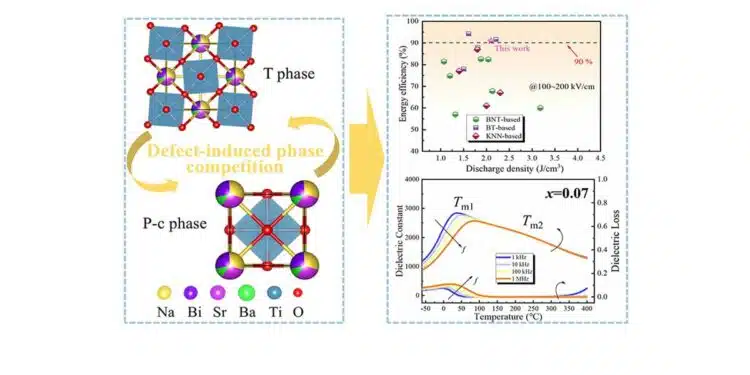Researchers from Jingdezhen Ceramic University, Institute of Tsinghua University, Zhejiang province, China reported aliovalent doped Sm0.07-BNBST ceramics to achieve a high energy efficiency of 91% together with a recoverable energy density of 2.1 J/cm3 at a low electric field of 114 kV/cm, which exceeds other reported dielectric materials at the same electric field.
High-quality relaxor ferroelectric BNT-based ceramic dielectrics achieved high discharge density by many methods of chemical doping, hierarchical structure design, advanced sintering technology, and defect structure engineering.
Unfortunately, the inferior energy efficiency of BNT-based ceramics is still at a level of 60 to 70%, which means a large portion of stored energy is dissipated generating more joule heat. Notably, low energy efficiency is a long-time neglected but important issue, and corresponding solutions need to be developed.
Recently, a research group of dielectric materials for energy storage capacitor led by Prof. Dr. Zong-Yang Shen from Jingdezhen Ceramic University, reported aliovalent rare earth ion Sm3+-doped relaxor ferroelectric Ba0.12Na0.3Bi0.3Sr0.28SmxTiO3 (abbreviated as Smx-BNBST) solid solutions thorough defect-engineered phase/domain structure competition. Sm0.07-BNBST ceramics achieve a high energy efficiency of 91% together with a recoverable energy density of 2.1 J/cm3 at a low electric field of 114 kV/cm, which exceeds other reported dielectric materials at the same electric field.
“In this work, we proposed that defect-induced phase competition between tetragonal phase P4bm and pseudo-cubic phase Pm3m not only strengthens polarization switching ability but also improves dielectric temperature stability via thermal evolutions. More importantly, a high 91% energy efficiency with discharge density of 2.1 J/cm3 was achieved in Sm0.07-BNBST ceramics at a low electric field of 114 kV/cm, which is closely related to a reduced Pr demonstrated by PFM measurement.” said Prof. Zong-Yang Shen, vice dean at School of Materials Science and Engineering, Jingdezhen Ceramic University (China), whose research interests include dielectric ceramics for high power density energy storage capacitors, and high Curie temperature piezoelectric ceramics.
“Reduced domain size determines the remanent polarization (Pr), while the competition between tetragonal phase and pseudo-cubic phase determines the maximum polarization (Pmax). For the x=0 composition, it exhibits obvious ferroelectricity with increasing voltage; and after the electric field is removed, the polarization direction is still maintained and difficult to return to the initial state, corresponding to a high Pr. For the x=0.07 composition, the ferroelectricity is significantly weakened; when the external voltage is removed, the polarization direction can quickly return to the initial state, corresponding to a low Pr. The rapid response of polarization switching in Sm0.07-BNBST ceramics indicates that it has highly active polar nanoregions (PNRs), which produce low Pr and moderate Pmax, contributing to enhanced energy density and efficiency.” said Zong-Yang Shen.
“As the Sm concentration increases, the P-E loops of Smx-BNBST ceramics gradually become slimmer, and both Pmax and Pr gradually decrease, indicating that Sm doping weakens the ferroelectricity. When the Sm equals to 0.07 mol, Pmax shows a sudden increase, which may be related to the synergistic contributions of tetragonal/pseudo-cubic phase competition and reduced domain size.” said Zong-Yang Shen.
“Compared with pure BNBST ceramics with one dielectric peak of <100 °C, Smx-BNBST ceramics exhibit a new weak dielectric peak near ~200°C, which should be related to the thermal evolution of defect-induced phase competition between tetragonal phase and pseudo-cubic phase in BNT ceramics. As the Sm concentration increases, the dielectric peaks gradually broaden, and corresponding transition temperature Tm1 shifts towards lower temperatures, strengthening the dielectric temperature stability.” said Zong-Yang Shen.
Prof. Zong-Yang Shen said “In the following work, we will do research on designing and analyzing the influence of defect structure on dielectric and ferroelectric behaviors of BNT-based ceramics.” He hopes to obtain a BNT-based ceramics with high discharge density and energy efficiency at low electric field, and then fabricate them into multi-layer ceramic capacitors (MLCCs) to advance the development of dielectric materials in practical applications.
Link to the scientific paper:
Li D-X, Deng W, Shen Z-Y, et al. Aliovalent Sm-doping enables BNT-based realxor ferroelectric ceramics with > 90% energy efficiency. Journal of Advanced Ceramics, 2024, https://doi.org/10.26599/JAC.2024.9220999































